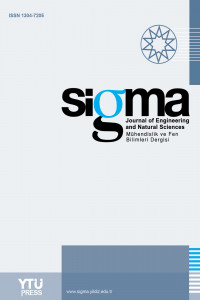Abstract
This study was carried out to determine the drinking water quality of İpsala, Keşan, Uzunköprü and Meriç Districts, which are located in the Meriç River Basin in Edirne Province of Turkey. Water samples were collected from 51 villages in autumn season of 2017. Some physical and chemical water quality parameters including dissolved oxygen, oxygen saturation, pH, electrical conductivity (EC), total dissolved solids (TDS), salinity, turbidity, nitrite (NO2), nitrate (NO3), phosphate (PO4) and cyanide (CN) were determined and the results were assessed according to national and international quality criteria. Pearson Correlation Index (PCI) and Principle Component Analysis (PCA) were applied to experimental data in order to determine the significant relations among the investigated parameters and effective factors on groundwater quality of the region. Geographic Information System (GIS) was also used in order to make a visual explanation by presenting distribution maps of investigated parameters. According to data observed, although the investigated parameter levels in drinking water of villages did not exceeded the limit values for drinking, the region has Class I – II water quality in terms of cyanide, nitrite and nitrate parameters; Class II – III in terms of electrical conductivity parameter; and Class III – IV in terms of phosphate parameter in general.
Keywords
Meriç River Basin Edirne villages drinking water quality principle component analysis MapInfo
References
- [1] Anonymous (2012). Edirne İl Çevre Durum Raporu (Environment Status Report of Edirne Province). Edirne Valiliği, ÇevreveŞehircilik İl Müdürlüğü.
- [2] Anonymous (2016). Edirne İl Çevre Durum Raporu (Environment Status Report of Edirne Province). Edirne Valiliği, ÇevreveŞehircilik İl Müdürlüğü.
- [3] Çiçek, A., Bakış, R., Uğurluoğlu, A., Köse, E., Tokatlı, C. (2013). The Effects of Large Borate Deposits on Groundwater Quality. Polish Journal of Environmental Studies, 22 (4): 1031-1037.
- [4] EC (European Communities) (2007). European Communities (drinking water) (no. 2), Regulations 2007, S.I. No. 278 of 2007.
- [5] Kazi, T. G., Arain, M. B., Jamali, M. K., Jalbani, N., Afridi, H. I., Sarfraz, R. A., Baig, J. A., Shah, A. Q. (2009). Assessment of water quality of polluted lake using multivariate statistical techniques: A case study. Ecotoxicology and Environmental Safety, 72: 301– 309.
- [6] Köse, E., Çiçek, A., Uysal, K., Tokatlı, C., Emiroğlu, Ö., Arslan, N. (2015). Heavy Metal Accumulations in Water, Sediment and Some Cyprinidae Fish Species from Porsuk Stream (Turkey). Water Environment Research, 87 (3): 195-204.
- [7] Liu, C. W., Lin, K. H., Kuo, Y. M. (2003). Application of Factor Analysis in the Assessment of Groundwater Quality in a Blackfoot Disease Area in Taiwan. Science of the Total Environment, 313, 77–89.
- [8] Manahan, S. E. (2011). Water Chemistry: Green Science and Technology of Nature's Most Renewable Resource. Taylor & Francis Group, CRC Press, 398 pages.
- [9] Self, J. R., Waskom, R. M. (2013). Nitrates in Drinking Water. Colorado State University Extension. 7/95. Revised 11/13.
- [10] TS 266 (2005). Sular-İnsani tüketim amaçlı sular. Türk Standartları Enstitüsü, ICS 13.060.20.
- [11] Tokatlı, C. (2014). Drinking Water Quality of a Rice Land in Turkey by a Statistical and GIS Perspective: İpsala District. Polish Journal of Environmental Studies, 23 (6): 2247-2258.
- [12] Tokatlı, C. (2015). Assessment of the Water Quality in the Meriç River: As an Element of the Ecosystem in the Thrace Region of Turkey. Polish Journal of Environmental Studies. 24 (5): 2205-2211.
- [13] Tokatlı, C. (2017). Bio – Ecological and Statistical Risk Assessment of Toxic Metals in Sediments of a Worldwide Important Wetland: Gala Lake National Park (Turkey). Archives of Environmental Protection, 43 (1): 34-47.
- [14] Tokatlı, C., Baştatlı, Y. (2016). Trace and Toxic Element Levels in River Sediments. Polish Journal of Environmental Studies, 25 (4): 1715-1720.
- [15] Tokatlı, C., Köse, E., Çiçek, A. (2014). Assessment of the Effects of Large Borate Deposits on Surface Water Quality by Multi Statistical Approaches: A Case Study of The Seydisuyu Stream (Turkey). Polish Journal of Environmental Studies, 23 (5): 1741-1751.
- [16] Turkish Regulations (2004). Yüzeysel Su Kalitesi Yönetimi Yönetmeliği, 31 Aralık Cuma tarihli Resmi Gazete, Sayı: 25687, http://suyonetimiormansu.gov.tr.
- [17] Turkish Regulations (2015). Yüzeysel Su Kalitesi Yönetimi Yönetmeliği, 15 Nisan 2015 tarihli Resmi Gazete, Sayı: 29327, http://suyonetimiormansu.gov.tr.
- [18] Uslu, O., Türkman, A. (1987). Su Kirliliği ve Kontrolü. T.C. Başbakanlık Çevre Genel Müdürlüğü Yayınları, Eğitim Dizisi I, Ankara.
- [19] Wetzel, R. G. (2001). Limnology: Lake and River Ecosystems. Elsevier Academic Press, 1006 pages.
- [20] WHO (World Health Organization) (2011). Guidelines for Drinking-water Quality. World Health Organization Library Cataloguing-in-Publication Data, NLM classification: WA 675.
Details
| Primary Language | English |
|---|---|
| Subjects | Engineering |
| Journal Section | Research Articles |
| Authors | |
| Publication Date | September 1, 2018 |
| Submission Date | November 17, 2017 |
| Published in Issue | Year 2018 Volume: 36 Issue: 3 |
IMPORTANT NOTE: JOURNAL SUBMISSION LINK https://eds.yildiz.edu.tr/sigma/


